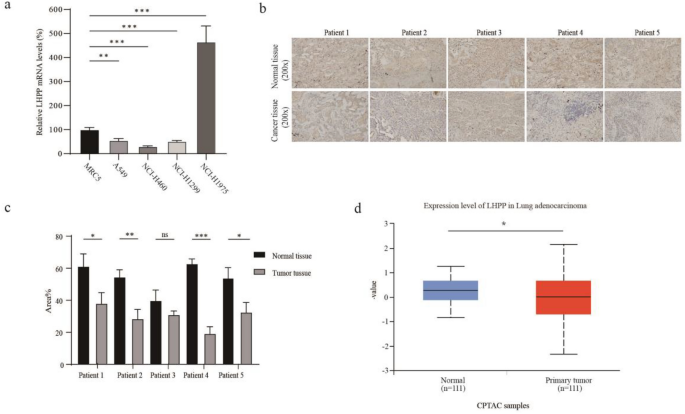Oncolytic adenovirus encoding LHPP exerts potent antitumor effect in lung cancer
- Select a language for the TTS:
- UK English Female
- UK English Male
- US English Female
- US English Male
- Australian Female
- Australian Male
- Language selected: (auto detect) - EN

Play all audios:

LHPP has been shown to be a new tumor suppressor, and has a tendency to be under-expressed in a variety of cancers. Oncolytic virotheray is a promising therapeutics for lung cancer in recent
decade years. Here we successfully constructed a new recombinant oncolytic adenovirus GD55-LHPP and investigated the effect of GD55-LHPP on the growth of lung cancer cells in vitro and in
vivo. The results showed that LHPP had lower expression in either lung cancer cells or clinical lung cancer tissues compared with normal cells or tissues, and GD55-LHPP effectively mediated
LHPP expression in lung cancer cells. GD55-LHPP could effectively inhibit the proliferation of lung cancer cell lines and rarely affected normal cell growth. Mechanically, the oncolytic
adenovirus GD55-LHPP was able to induce stronger apoptosis of lung cancer cells compared with GD55 through the activation of caspase signal pathway. Notably, GD55-LHPP also activated
autophagy-related signal pathway. Further, GD55-LHPP efficiently inhibited tumor growth in lung cancer xenograft in mice and prolonged animal survival rate compared with the control GD55 or
PBS. In conclusion, the novel construct GD55-LHPP provides a valuable strategy for lung cancer-targeted therapy and develop the role of tumor suppress gene LHPP in lung cancer gene therapy.
According to the latest statistics, the incidence and mortality rates of lung cancer rank first in all cancer types throughout the worldwide, and the 5 year overall survival rate is less
than 20%1,2.Current treatment strategies such as surgery, chemotherapy, radiotherapy, and molecular targeting therapy as well as immunotherapy are ineffective against advanced tumors.
Therefore, there is still an urgent need to search novel approaches to treat lung cancer.
Oncolytic virotherapy has recently been considered as one of the most promising strategies for the treatment of solid tumors due to its tumor-targeting ability and high efficiency3,4. Our
group has been working on Cancer-targeting gene-virotherapy (CTGVT) through inserting anti-tumour genes into oncolytic virus vectors, such as adenoviral vector and vaccinia vector5,6, which
has obtained better anti-tumour effect compared to oncolytic virus alone and gene therapy alone.
GP73, is a Golgi glycoprotein, also called GOLPH2 and is upregulated in a wide range of cancers7,8. It is an excellent candidate marker for hepatocellular carcinoma, and its specificity is
even better than that of the hepatocellular carcinoma marker AFP9. Previously, we constructed a GP73-regulated oncolytic adenovirus (GD55) based on ZD55 of CTGVT, exhibits a stronger
oncolytic effect compared to common oncolytic adenovirus in human liver cancer stem-like cells10, human prostate cancer stem-like cells5, and hepatocellular carcinoma11either in vivo or in
vitro. It showed that GD55 has an excellent antitumor potential as oncolytic virus vector to deliver tumor suppression gene.
In recent years, phosphoinositide phosphohistidine inorganic pyrophosphate phosphatase (LHPP), a histidine phosphatase, has been shown to be a new tumor suppressor12.Low expression of LHPP
has also been found in cancer tissues of bladder cancer13, lung cancer, pancreatic cancer14,15, cervical cancer16, papillary thyroid cancer17, and colorectal cancer18,19. Overexpression of
LHPP protein inhibits hepatocellular carcinoma cell growth and metastasis, and also reduces the transcription of CCM1, PKM2, MMP7, and MMP9 in cancer cells, and that high expression of LHPP
was negatively correlated with cell cycle and metastasis, among others20. It suggests that LHPP is lung cancer suppressor with potent.
In this study, we constructed a novel oncolytic adenovirus GD55-LHPP in which GD55 was used to carry LHPP gene, and investigated the role of GD55-LHPP on lung cancer cells. The results
showed that GD55-LHPP mediated high expression of LHPP in lung cancer cells and inhibited efficiently lung cancer cell growth in vivo and in vitro. Thus, our results implied that GD55-LHPP
might act as a promising therapeutic agent for lung cancer.
The expression of the tumor suppressor LHPP is often absent or lowered in various types of human cancers due to the loss of heterozygosity and promoter hypermethylation21. Here, we first
detected LHPP expression in several lung cancer cell lines, and found LHPP expression was down-regulated in detected lung cancer cells except H1975 compared with the human embryonic lung
cell line MRC-5 in mRNA level. (Fig. 1a, Supplementray Table 1). Furthermore, it was found that LHPP expression was clearly weakened in five lung cancer tissue specimens compared with
paracancer normal tissues (Fig. 1b and c). It is consistent with low expression of LHPP in lung adenocarcinoma derived from CPTAC samples (https://ualcan.path.uab.edu/) (Fig. 1d). The above
results suggest LHPP might be a candidate lung cancer suppressor.
Low expression of LHPP in lung cancer cells and tissues (a) The expression of LHPP mRNA in normal lung cell lines and different lung cancer cell lines by RT-qPCR . **P